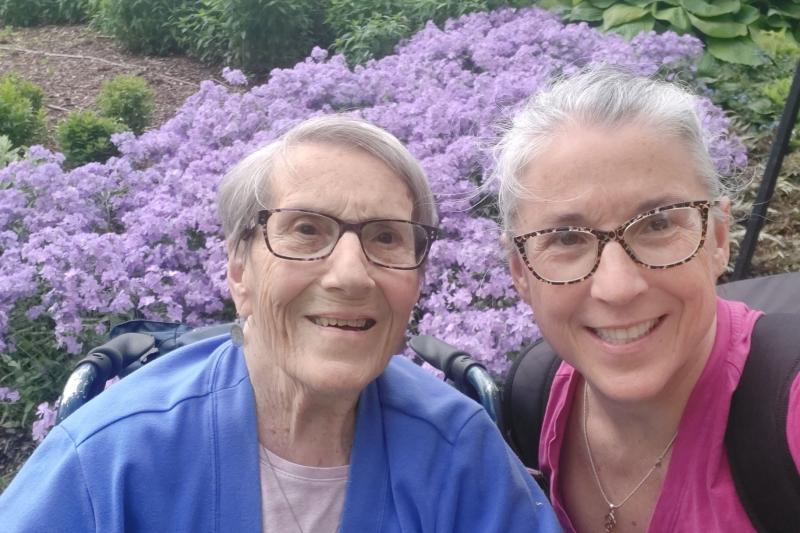After qualifying for home care services, Pauline Kane sat on a waitlist for more than a year. In the meantime her daughter, Ann Marie Kane, who goes by her initials A.M.K., had moved in with her and was caring for her around the clock — without getting paid.
Pauline Kane, who is 86, has a neurological disorder that makes it difficult to walk or stand on her own, so A.M.K. helps with everything from making meals to showering. She’s concerned about her mom falling if left on her own in their Scarborough home, so A.M.K. brings her when running errands.
“She doesn’t go anywhere without me,” Pauline Kane said. If she didn’t have her daughter caring for her, Kane said, “I’d have to go into a nursing home. I don’t think I’d like it because there would be nobody around to talk to or for me to go out with.”
When Kane finally got off the waitlist in 2022, she was approved for about 24 to 32 hours through a state-funded waiver called Section 63, for people whose medical needs qualify for additional assistance but who have too much income to qualify for Medicaid. “I honestly don’t even know what (the number of approved hours) is right now because no matter what it is, I will do the same job every day,” A.M.K. said.
Kane now uses the funds to pay A.M.K., and realizes she is lucky to have someone who can work well beyond the number of hours she’s being paid. A.M.K. was hired by a staffing agency in her area to work as her mom’s caregiver full-time.
There are multiple home care waivers that allow Mainers who medically qualify for additional assistance (like care in a nursing home or assisted living) to opt instead to receive that level of care in their homes. But for those who do want care at home, many have been unable to find caregivers to work for all the hours they’ve been approved for.
A recent state report showed that 71 percent of around 1,500 people receiving the Section 63 voucher were not receiving all the personal support services or nursing hours they’d been approved for.
However, the Department of Health and Human Services said there is no mechanism to know the scale of these deficits — it is unclear whether someone in this group is receiving, for instance, 30 of their 32 hours or a much smaller amount.
The percentage of people receiving fewer hours than approved for under MaineCare or state-funded programs has increased markedly over the prior year — a problem advocates say underscores workforce shortages and increasing demand.
Gov. Janet Mills’ administration has dedicated significant resources to bolster the healthcare workforce, but advocates worry that attention to the problem is waning.
The number of people who qualify for waiver Section 19, which is for older people and adults with disabilities who qualify for MaineCare (the state’s version of Medicaid) stayed roughly the same but the proportion who are not receiving all of the hours they’ve been authorized increased from 33 percent in November 2022 to 50 percent in December 2023.
For waiver Section 96, which funds private duty nursing and personal care services, the share of people who are “partially staffed” went from 47 percent in November 2022 to 62 percent in December 2023. The number of enrollees was about the same.
Lindsay Hammes, a DHHS spokesperson, said there are a couple of explanations, including the fact that the latest report combines the home care hours that are partially and fully unstaffed, whereas this data was broken into separate categories in previous reports. She added that a nursing agency in 2022 stopped providing nursing services that supported these programs.
“As more people become eligible for the service, providers continue to struggle to hire qualified staff,” Hammes said.
Jess Maurer, executive director of the Maine Council on Aging, said the problem stems from a strapped labor market and low reimbursement rates for providers. She said DHHS and the Department of Labor have worked to attract people to direct care jobs, including by increasing wages for all essential care workers to 125 percent of minimum wage, or about $17.70 hourly.
“That’s great but it hasn’t helped,” she said. “The reality is that at some point we’re going to have to pay a market-driven rate.”
Maurer said the home care deficit could result in someone who is entitled but not receiving home-based care having an avoidable health crisis and ending up in the hospital, only to sit there for days or weeks instead of being discharged because there’s no home care nor available beds in nursing homes.
Hammes said an ongoing rate study is reviewing similar services across MaineCare sections, including home- and community-based clinical, therapy, care coordination, supportive skills building, and assistive technology services. She said the study is part of the department’s goal to address “severe state labor shortages for nurses,” which has contributed to a decline in people accessing these services.
“This effort may also help to address rate disparities across other relevant positions which are also experiencing labor shortages,” Hammes said.
How it works
To qualify for home care, a client must be assessed to see whether their medical needs qualify for additional assistance. If they do and the person opts for home care, they are connected with a care coordination agency, such as SeniorsPlus.
Betsy Sawyer-Manter, president and CEO of SeniorsPlus, said her agency serves about 3,000 people who have been approved for some level of in-home help. As a coordination agency, the group helps clients get connected with someone to provide care. But they also conduct an assessment to look at what else they might need, and connect them with the appropriate services.
While their numbers can fluctuate daily, Sawyer-Manter said SeniorsPlus has 756 completely unstaffed clients, which is slightly lower than past years. She said the demand for services is high and she expects it to only grow, especially as Maine nursing homes continue to close.
More than 23 nursing homes in Maine have closed in the last decade, with the most recent closure of Narraguagus Bay Health Care Facility reported last month.
“There is a significant amount of demand,” said Tracy Smith, the long-term services and support director for SeniorsPlus. “There are many clients who are living in areas where they don’t have family support, so this is essentially the only way they can get their needs met.”
The rural nature of the state could also be why someone has difficulty finding a caregiver, because fewer home care providers are nearby. Sawyer-Manter added that a lot of immigrants work in the field and clients are sometimes reluctant to have someone who isn’t as fluent in English provide their care. Sawyer-Manter noted that she’s seen this attitude improve recently.
Another part of the problem, Sawyer-Manter said, is the work itself is “not glamorous,” the pay is low and hours aren’t reliable. Home care workers help with bathing, dressing, cooking and transporting clients — tasks that should be valued, she said.
Sawyer-Manter said there’s been progress, including increasing the reimbursement rate to 125 percent of minimum wage and efforts to “destigmatize” the work.
Undivided attention
Ashlee Reynolds, a certified nursing assistant who provides home care services through Allmed Staffing of New England, said she chose the work because she likes the flexibility and chance to work one-on-one with a client. When she worked in a nursing home, she sometimes had to care for as many as 12 residents in one day. In home care, she can focus all her attention on one person.
She currently works with three clients, dividing her hours with each of them into two- or three-hour shifts each day. Her services range from helping with bathing and dressing, to providing transportation and running errands.
One of Reynolds’ clients has caregivers from two agencies because the original caregiver couldn’t add more hours.
Nate Charles, the home care manager with Allmed Staffing of New England, said his agency gets referrals for people seeking home care through waivers from care coordination agencies like SeniorsPlus. A mass email will go out to all 160 staffing agencies anytime there’s a new client.
Allmed Staffing provides personal support specialists and nonmedical staff that assist with basic house cleaning, groceries and meal preparation. If a client requires nursing care they would typically have a team of people that includes a registered nurse, he said.
Contrary to data that suggests a workforce shortage, Charles said he’s noticed a lot of demand among staffing agencies to sign new clients.
He said he has to respond within minutes to referrals for new clients or someone else will snap them up. He said this varies greatly based on where the client is located. His agency is based in Augusta and many of his care staff want to work with clients nearby. Someone in Aroostook County may have more difficulty finding a caregiver.
He’s also seen people opt not to use all the hours they’ve been allocated. This may be because they don’t want someone in their home that long or because their health deteriorates and they are approved for more hours, but want to stay with a particular caregiver who is unable to add hours.
What needs to be done
In response to the growing waitlist for Section 63, lawmakers in 2022 allocated about $6 million to get people off the waitlist so they can start receiving care. As a result, recipients such as Pauline Kane were finally able to access the funding.
As of February, there was no one on the waitlist. The number of enrollees in the program nearly doubled but the percentage of people receiving fewer than all their hours also increased from 53 to 71 percent.
Since then, however, a waitlist was reinstituted April 1 because “current funding cannot support additional participants at this time,” according to Hammes. There are currently 280 people on the waitlist.
Eliminating the waitlist — even temporarily — is still progress, according to Arthur Phillips, the economic policy analyst with the Maine Center for Economic Policy.
“It represents an investment in the program and that is something that we should commend,” he said.
However, Phillips said the available data offers an incomplete snapshot. Unlike previous versions of the report, DHHS did not release information on how many people have no caregiver whatsoever. And for those partially staffed, it’s unclear how many hours they are short.
“This once-annual snapshot is helpful but not nearly sufficient to measure the scale of the problem,” Phillips said.
While he applauded efforts to increase wages, and the governor’s allocation in 2022 of $120 million in recruitment and retention bonuses for home care workers, Phillips said the state has not gone far enough. He is working on a report that will look into the question of what range of wages could sufficiently draw new people into these careers.
He added that the caregiver shortages impact not only those who need the services but also their family members — like A.M.K. — who are left to pick up the slack.
“Care work should be thought of as infrastructure to allow other people to participate in the economy,” he said. “It’s really the backbone. If you don’t have access to the care a loved one needs, you can’t stay in your career.”
To incentivize a system where older Mainers can stay at home longer, A.M.K. argues that family caregivers should be paid directly as state employees, eliminating the costs of assessments, case managers and staffing agencies.
“People think long-term care is just if you’re an institution,” A.M.K. said. “They separate it: ‘An institution is eligible for this kind of money because they’re an institution, but if you are going to care for a loved one, oh well; we will give you a couple bucks an hour.’ ”
Hammes, the DHHS spokesperson, said the department is also starting a process to implement reimbursement for home health aide services provided by qualified parents to minor children. A state plan amendment will be submitted next month and there will be opportunities for interested parties to inform future rulemaking, she said.
Maurer said she’s worried attention to the problem is starting to wane. She was disappointed to see a workforce bill fail during the recent legislative session. The measure would have created tuition reimbursement for a direct care worker providing in-home or community support services and could be transferred to family members, which she said would make the jobs more attractive.
Sawyer-Manter echoed her sentiment, saying she hopes there isn’t fatigue around workforce initiatives.
“There are lots of things we could certainly invest in but this is one that isn’t going to go away,” she said. “We need to take care of our older people and people with disabilities. It’s a Maine value that we take care of our people.”
































